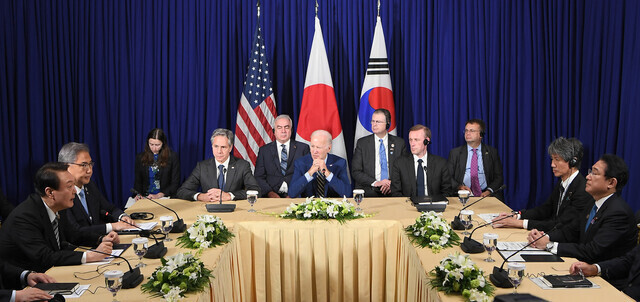hankyoreh
Links to other country sites 다른 나라 사이트 링크
Yoon swaps out NE Asia for focus on US, Indo-Pacific in S. Korea’s foreign policy

The emphasis that President Yoon Suk-yeol put on his Indo-Pacific strategy during his tour of Southeast Asia is raising some concerns that South Korea has lost focus on resolving the issue of North Korea’s nuclear program. Some point out that there’s a growing possibility of South Korea becoming embroiled in disputes that don’t stand to benefit the national interest.
During his overseas trip, Yoon underscored the “Indo-Pacific” rather than “Northeast Asia” during the ASEAN and G20 summits, an example of which can be found in the Phnom Penh Statement on US-Japan-Republic of Korea Trilateral Partnership that he signed.
At his first stop, Phnom Penh in Cambodia, Yoon introduced his Indo-Pacific strategy by declaring, “We live in an Indo-Pacific era,” at the Korea-ASEAN summit, noting that “the region accounts for 65% of the world’s population, more than 60% of its GDP, and half the world’s maritime transportation passes through here.”
In the joint statement with the US and Japan, Yoon condemned North Korea’s ballistic missile launches and strengthened extended deterrence. At the same time, he put his weight behind the US and Japan’s efforts to blockade China, such as freedom of navigation in the South China Sea, opposition to attempts to change the status quo in the Indo-Pacific and maintaining peace and stability across the Taiwan Strait.
At a critical time when rumors of a seventh nuclear test by North Korea do not seem far-fetched, there are concerns about South Korea’s diplomatic power being spread thin to cover issues like the territorial dispute in the South China Sea or an armed conflict over Taiwan, rather than focusing on issues directly related to South Korea.
The shift of focus from Northeast Asia to the Indo-Pacific can also be seen in recent moves by the Ministry of Foreign Affairs.
Yoon’s Indo-Pacific strategy aims to replace Moon Jae-in’s “Northeast Asia Plus Community of Responsibility. This so-called community was a government policy task focused on the Asian region that relied on Northeast Asia Peace and Cooperation Platform and New Northern/New Southern policies.
Rather than concentrate on stakeholder nations for resolving issues faced by the Korean Peninsula, Yoon is shifting focus to beyond the immediate Northeast Asian region.
According to data released by lawmaker Kim Sang-hee of the Democratic Party on Thursday, the Ministry of Foreign Affairs has renamed the Northeast Asia Peace and Cooperation Platform to the “East Asia Cooperation Forum.” By changing the name, the Ministry of Foreign Affairs has also expanded the range of countries involved from the original South Korea, North Korea, Russia, Mongolia, China, Japan, and the US to include Southeast Asia, India and the Pacific Islands.
As such, some are criticizing that this shift in diplomatic focus to the Indo-Pacific region may detract from the focus on resolving the issue of a nuclear North Korea.
Lee Hea-jeong, professor at Chung-Ang University, said, “Korean foreign policy has always had space for geopolitical strategies focusing on the Korean Peninsula, whether it was a conservative government or a progressive one — the Park Geun-hye administration had the ‘Northeast Asia Peace and Cooperation Initiative’” and the Moon Jae-in administration had the ‘New Northern/Southern Policies.’”
He went on to say that “by only focusing on the Indo-Pacific strategy, it seems that Yoon’s foreign policy narrows our diplomatic options even more than the Park Geun-hye administration.”
By Shin Hyeong-cheol, staff reporter
Please direct questions or comments to [english@hani.co.kr]

Editorial・opinion
![[Editorial] Penalties for airing allegations against Korea’s first lady endanger free press [Editorial] Penalties for airing allegations against Korea’s first lady endanger free press](https://flexible.img.hani.co.kr/flexible/normal/500/300/imgdb/original/2024/0502/1817146398095106.jpg) [Editorial] Penalties for airing allegations against Korea’s first lady endanger free press
[Editorial] Penalties for airing allegations against Korea’s first lady endanger free press![[Editorial] Yoon must halt procurement of SM-3 interceptor missiles [Editorial] Yoon must halt procurement of SM-3 interceptor missiles](https://flexible.img.hani.co.kr/flexible/normal/500/300/imgdb/child/2024/0501/17145495551605_1717145495195344.jpg) [Editorial] Yoon must halt procurement of SM-3 interceptor missiles
[Editorial] Yoon must halt procurement of SM-3 interceptor missiles- [Guest essay] Maybe Korea’s rapid population decline is an opportunity, not a crisis
- [Column] Can Yoon steer diplomacy with Russia, China back on track?
- [Column] Season 2 of special prosecutor probe may be coming to Korea soon
- [Column] Park Geun-hye déjà vu in Yoon Suk-yeol
- [Editorial] New weight of N. Korea’s nuclear threats makes dialogue all the more urgent
- [Guest essay] The real reason Korea’s new right wants to dub Rhee a founding father
- [Column] ‘Choson’: Is it time we start referring to N. Korea in its own terms?
- [Editorial] Japan’s rewriting of history with Korea has gone too far
Most viewed articles
- 160% of young Koreans see no need to have kids after marriage
- 2Presidential office warns of veto in response to opposition passing special counsel probe act
- 3Months and months of overdue wages are pushing migrant workers in Korea into debt
- 4[Editorial] Penalties for airing allegations against Korea’s first lady endanger free press
- 5Japan says it’s not pressuring Naver to sell Line, but Korean insiders say otherwise
- 6S. Korea “monitoring developments” after report of secret Chinese police station in Seoul
- 7Hybe-Ador dispute shines light on pervasive issues behind K-pop’s tidy facade
- 8Inside the law for a special counsel probe over a Korean Marine’s death
- 9USFK sprayed defoliant from 1955 to 1995, new testimony suggests
- 101 in 5 unwed Korean women want child-free life, study shows